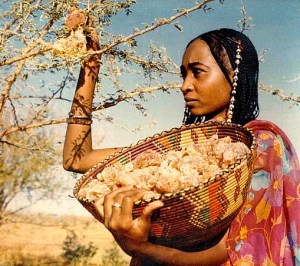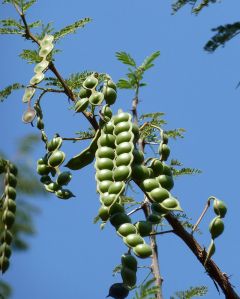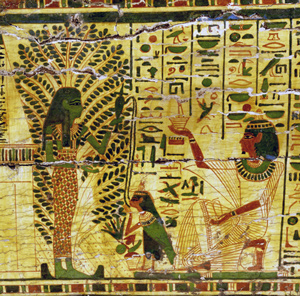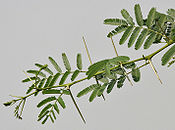Here in the Pacific Northwest, we are finally experiencing some rather lovely Labor Day weather.
Yesterday, our community rehearsed for the Fall Equinox Festival. (“The Descent of Inanna.” Oh my. If you are in the area, do come. It will be magic and Mystery.) Today, we go to find early September’s peaches and tomatoes from local farms. Those may be my two most favorite things to eat…with Oregon blackberries close behind. And those luscious, prickly darlings grow wild here.
So for today’s entry, I am feeling a bit laid back. Let us then explore one of Isis’ many symbols and affinities. This time, something growing, something wild, something not native to Oregon…but which is native to Egypt: the acacia.
There are many species of acacia, medium-sized, thorny trees with rough, dark bark that can be found in the arid parts of Africa and Asia.
In parts of Africa, the trees characteristically have a dome-shaped canopy because of the way the giraffes graze them. Yet the acacia has developed what seems like an almost miraculous defense system. The tree senses its leaves being grazed. This triggers the release into the acacia’s leaves of a poisonous tannin—so poisonous, if enough is consumed, it can even be deadly.
Researchers discovered this when they observed giraffes browsing only one in ten acacia trees, while antelopes on a fenced game ranch that could not roam freely ate acacia and died. Furthermore, the tree emits a chemical, ethylene, into the air that can travel on the breeze about 50 feet to alert nearby acacia trees—and they produce the tannin, too.
While the ancient Egyptians may not have been aware of the less observable aspects of this cycle, they clearly recognized acacia as special—both practically and magically.
On the practical side, the Egyptian acacia, acacia nilotica, has many, many uses. Acacia, called shont, shonnet, shondj, or shondet in Egyptian (it is called sont in modern Arabic), is an attractive hardwood from which the ancient Egyptians built, among other things, boats, sarcophagai, and furniture.
… the Boat of Ra arrived at the town of Het-Aha; its forepart was made of palm wood, and the hind part was made of acacia wood; thus the palm tree and the acacia tree have been sacred trees from that day to this.
The Legend of Horus of Behutet and the Winged Dis
Acacia’s sweet smelling, yellow flowers, which look like little yellow sunbursts, are astringent and were used to help cleanse the skin and clear up skin problems. Brewed acacia leaves were drunk in a cough mixture. They were also applied to wounds and swollen limbs for their astringent properties. The tree’s seedpods are edible by livestock. The crushed bark produces tannin that was used to help heal burns and tan leather.
Gum acacia (aka “gum arabic”), a resin exuded by the tree, has an amazing variety of uses. It is edible and is extremely nutritious. During the gum harvest, modern-day pickers are said to live almost entirely on it, and just six ounces is enough to sustain an adult for a day.
Gum acacia assists in blending and smoothing fats, so it is often used in candy making. It can be used in medicines, incense, paint, and even as glue. Ancient Egyptian women used gum acacia, blended into a base of dates and honey, as a contraceptive. And it worked, too. When gum acacia is dissolved, it produces lactic acid, a spermacide.
DMT, a hallucinogen associated with spiritual experiences, may be present in acacia nilotica in low doses. It is, however, present in other species of acacia in higher doses. This has, of course, led some to speculate that the Egyptians may have used the drug as a way to contact the Otherworld.
And that thought is the perfect crossover to look into acacia’s magical potentcies.
The acacia could represent both life and death for it was thought to encompass both. As the antelopes learned, the tree can be deadly, though it is more often connected with life and healing. The tree is evergreen, making it an apt tree of life. Its yellow flowers look like small suns, making it a solar and renewing, tree. Among the virtues of acacia recorded by Pliny, is a quality that would seem to associate it with resurrection and renewal:
…but the principal merit that it possesses is, that when it is cut down, it will grow again within three years.
Pliny, Natural History, Book XIII, chapter 19
In one of the formulae of the Coffin Texts, wood from the Goddess Saosis’ (that is, Iusaaset, the primordial Grandmother of Creation and the Gods, sometimes identified with Hathor or Isis) sacred acacia is crushed by the deceased for its healing properties.
In another, the acacia provides an unidentified instrument of power that enables the deceased to avoid evil things in the Otherworld. In yet another text, the acacia appears to be an ingredient in a divine mortar.
The acacia is also associated with the Double Lion, the twin lions Who guard the horizon to the Otherworld.
The Egyptians must have considered the acacia an ancient, even primordial, tree. In the Book of Coming Forth by Day, the deceased says that he stands before Anubis in a time before the acacia was born, that is, In The Beginning, before the Deities had established All Things. At Heliopolis, there was a tradition that all the Goddesses and Gods were born beneath an acacia tree. In the Book of Coming Forth by Day, the deceased goes to “the Acacia Tree of the Children;” probably the Divine Children of Iusaaset, the Goddesses and Gods born beneath the sacred acacia.

While the acacia is associated with a number of Egyptian Deities, it has specific associations with Isis and Her family. A particular acacia—simply called The Acacia, or Shondj—was sacred to Her. The Goddess Shontet, the Acacia Goddess Who took part in the Osirian resurrection rites at Djedu (Mendes), was considered to be a form of Isis. Isis and Nephthys together were called the Two Shonti Goddesses, that is, the Two Acacia Goddesses.
In the story of the “Contendings of Horus and Set,” Isis, in the form of Her sacred bird, flies into the branches of Her holy acacia after tricking Set into condemning His own attempts to usurp the rightful rule of Horus, Isis’ son. In some tales, the acacia is the tree that magically grew up around the body of Osiris when His sarcophagus washed up on the shores of Byblos. He is called “the One in the Tree” and “the Solitary One in the Acacia.” In the Pyramid Texts, Horus, “comes forth from the acacia tree.”
In one of the poison-curing spells that include the legend of “Isis & the Seven Scorpions,” when Horus is stung and cries out in pain, it is the doorkeepers at the Temple of the Holy Acacia Tree who hear Him and send a cry to the heavens for help, since Isis is away making libations for Osiris.
Because of Divine associations like these, acacia could serve as an offering to both Horus and Isis—and although I haven’t run across it yet, it would seem that acacia would be a very appropriate offering for Osiris as well.
The acacia is a tree of beauty, usefulness, powerful protection, life and death, and the magic of healing…and thus it is sacred unto Isis, Iset Shontet, the Lady of the Acacia.







There seems to have been a widespread association in the ancient world between acacia of various species and resurrection/rebirth. The acacia plays a very important role in the various versions of the Masonic legend of Hiram Abiff, and whether there is a direct, specific link with the ancient world there or not, there are similar legends all around the “neighborhood.” I did a quick double-check on my failing memory to make sure I wasn’t making up the connection with the “shittim wood,” of which the Ark of the Covenant and other articles of the Tabernacle of Moses were constructed and overlaid with gold. I’m relieved my memory is still holding 🙂 Also, the International Standard Bible Society’s online site notes the Arabic word and various minor spelling variants, all quite recognizably close to “shont.” It’s a remarkable tree, with remarkable wood (“incorruptible” wood), and amazing properties I didn’t know about–DMT, gum acacia/”arabic,” etc.
So interesting! It is a magical wood. Thank you for this!
I grew up with a few acacia trees – not the same ones as in Africa but the European versions since I lived in Romania. I always somewhat liked the acacia tree that was in our neighbourhood a bit more because it is so unusual to see a tree with thorns on it and then having these multiple, round and soft leaves on it. As children, we used to use the different size of the leaves as different amount of “currency” when we played ” shopping at the market” XD. It’s great to see this tree genus show up tied to the myth of Isis and Osiris. Much love to the tree, Isis and Osiris. 🙂